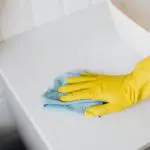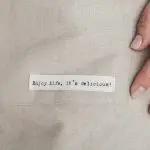So, you've found yourself in a sticky situation with hot glue on your favorite fabric. No need to panic, because we've got you covered with 10 easy ways to remove hot glue from fabric.
From the freezing method to using nail polish remover, these techniques will help you master the art of hot glue removal without damaging your fabric.
Whether you're a crafting enthusiast or just dealing with an accidental spill, these methods will have you saying goodbye to hot glue stains in no time.
Let's dive in and learn how to tackle this pesky problem like a pro.
Key Takeaways
- Freezing the hot glue before scraping it off helps preserve the fabric integrity.
- Using a vinegar solution can be an effective natural stain remover for hot glue stains.
- Rubbing alcohol can be used to soften the hot glue and make it easier to remove.
- Soaking the fabric in hot water can help break down the adhesive properties of the hot glue.
Freezing Method
To remove hot glue from fabric using the freezing method, place the affected area in the freezer for approximately 30 minutes. This simple technique takes advantage of the fact that hot glue becomes brittle and less adhesive when exposed to cold temperatures. Once the 30 minutes have elapsed, carefully remove the fabric from the freezer and use a blunt tool, like a butter knife or the edge of a credit card, to gently scrape off the frozen glue. The freezing effectiveness of this method lies in the fact that the glue hardens, making it easier to remove without damaging the fabric.
One of the advantages of using the freezing method is its fabric preservation. Unlike other removal methods that may involve harsh chemicals or vigorous scraping, freezing the hot glue is gentle on the fabric. This helps to minimize the risk of causing any damage to the fibers, colors, or texture of the fabric.
It's crucial to ensure the fabric is completely dry before using it to prevent any potential damage.
Ironing Technique
When dealing with hot glue on fabric, you can utilize the ironing technique to effectively remove the adhesive without causing damage to the fabric.
Here's how you can use this method:
- Fabric Protection: Place a thin fabric or a piece of parchment paper over the hot glue spot to protect the fabric from direct contact with the iron.
- Heat Settings: Set your iron to a low to medium heat setting. High heat can cause the glue to spread and become more difficult to remove.
- Preparation: Before ironing, ensure that the fabric is clean and free of any loose debris. This will prevent any particles from getting further embedded in the fabric.
- Ironing Process: Gently press the iron onto the protected area for a few seconds, allowing the heat to soften the glue. Be careful not to apply too much pressure, as this could spread the glue further.
- Peeling Off: After heating the glue, carefully peel it off with a pair of tweezers or your fingers. If any residue remains, repeat the process until the fabric is clean.
Vinegar Solution
If you've got hot glue on your fabric, a vinegar solution can be a game-changer. Mix equal parts of vinegar and water, then soak the affected area and scrub gently.
After that, rinse the fabric with water and watch the hot glue disappear.
Vinegar and Water
Once you have confirmed that the fabric is safe to treat with vinegar, you can proceed to create a vinegar solution for removing hot glue. Here's how to make and use the vinegar solution effectively:
- Mix equal parts of white vinegar and water in a bowl.
- Dab the vinegar solution onto the hot glue stain using a clean cloth.
- Gently work the solution into the fabric, allowing it to penetrate the glue.
- Let the solution sit for a few minutes to break down the adhesive bond.
- Blot the area with a clean cloth to lift the hot glue stain from the fabric.
Remember to test the vinegar solution on a small, inconspicuous area of the fabric first to ensure compatibility.
Soak and Scrub
You can begin the process of soaking and scrubbing the vinegar solution into the fabric to effectively remove the hot glue stain. Vinegar is a natural stain remover and can be gentle on various types of fabric. Follow these steps for effective stain removal and fabric care:
| Steps to Soak and Scrub (Vinegar Solution) |
|---|
| Step 1: Mix equal parts of white vinegar and water in a bowl. |
| Step 2: Soak a clean cloth in the vinegar solution. |
| Step 3: Gently dab the hot glue stain with the cloth, allowing the solution to penetrate the fabric. |
| Step 4: Let the fabric sit for 10-15 minutes to allow the vinegar solution to break down the glue. |
| Step 5: Scrub the stained area with a soft-bristled brush or toothbrush, then rinse with water. |
This method offers a simple yet effective way to remove hot glue from fabric while caring for the fabric's integrity.
Rinse With Water
To continue the process, gently rinse the fabric with water to remove the vinegar solution and any remaining hot glue residue. This step is crucial for fabric care and effective glue removal. Here's how to do it:
- Fill a clean bucket or sink with lukewarm water.
- Submerge the fabric in the water and swish it around to dislodge any remaining glue particles.
- Gently squeeze the fabric to help release the glue residue.
- If necessary, repeat the rinsing process until the fabric is free of any glue remnants.
- Finally, carefully wring out the excess water from the fabric and allow it to air dry completely.
Rubbing Alcohol
Rub rubbing alcohol onto the hot glue stain with a clean cloth to begin breaking down the adhesive. This method is effective for removing hot glue from fabric, especially in small and delicate areas. Rubbing alcohol is best applied by pouring a small amount onto the stained area and using a clean cloth to gently dab and rub the alcohol into the glue. Be cautious when using rubbing alcohol on colored or delicate fabrics, as it may cause discoloration or damage. To prevent this, test the rubbing alcohol on a small, inconspicuous area of the fabric first.
Additionally, it's important to work in a well-ventilated area and avoid inhaling the fumes. When using rubbing alcohol, it's essential to follow safety precautions such as wearing gloves to protect your skin. After applying the rubbing alcohol, gently scrape off the softened hot glue with a butter knife or a similar blunt tool. Repeat the process until the hot glue is completely removed, then launder the fabric as usual.
Hot Water Soak
So you've got some hot glue stuck on your favorite fabric, and you're looking for an easy way to remove it.
Well, a hot water soak might just do the trick. The heat from the water can help break down the glue, making it easier to gently remove without damaging the fabric.
Heat Breaks Down Glue
Applying hot water and soaking the fabric can effectively break down the hot glue for easier removal. The heat from the water helps to weaken the adhesive properties of the glue, making it simpler to lift off the fabric. Here's how to do it:
- Fill a bowl with hot water.
- Submerge the fabric with the hot glue into the bowl.
- Let it soak for 5-10 minutes to allow the hot water to penetrate the glue.
Gently peel off the softened glue using a blunt edge or your fingers.
Repeat the soaking process if necessary, until all the hot glue is removed.
Gentle Fabric-Friendly Technique
To effectively remove hot glue from fabric, gently soaking the affected area in hot water is an ideal way to break down the adhesive properties of the glue. This gentle fabric-friendly technique helps protect the fabric while effectively removing the hot glue. Here's a simple guide to help you execute this method:
| Steps | Instructions |
|---|---|
| Step 1: Heat the water | Heat water to a temperature that is tolerable for the fabric. |
| Step 2: Soak the fabric | Submerge the affected area in the hot water for 5-10 minutes. |
| Step 3: Gently peel the glue | After soaking, gently peel off the hot glue from the fabric. |
| Step 4: Rinse and dry | Rinse the fabric with cool water and allow it to air dry. |
| Step 5: Fabric protection | Use a fabric protector to restore any lost fabric protection. |
Lemon Juice Treatment
Try rubbing a generous amount of lemon juice directly onto the hot glue stain on the fabric. The natural acidity of the lemon juice can help break down the glue and lift it from the fabric fibers. Here are some steps you can follow for the lemon juice treatment:
- Squeeze fresh lemon juice onto the hot glue stain.
- Gently rub the lemon juice into the fabric using a soft-bristled brush or cloth.
- Allow the lemon juice to sit on the stain for 10-15 minutes to penetrate the glue.
- Rinse the fabric with cold water to remove the lemon juice and dissolved glue.
- Repeat the process if necessary until the hot glue stain is completely gone.
Lemon juice isn't only an effective natural remedy for hot glue removal but also aids in stain prevention on fabrics. Its gentle yet powerful properties make it a go-to solution for dealing with hot glue mishaps on clothing, upholstery, or other fabric items. With a little lemon juice and some patience, you can effectively tackle hot glue stains without damaging your fabrics.
Glycerin Application
Rubbing glycerin on the hot glue stain can effectively break down the adhesive and lift it from the fabric fibers. Glycerin benefits from its gentle yet powerful adhesive-dissolving properties, making it an ideal solution for removing hot glue from fabric.
To apply glycerin, dab a small amount onto the affected area and gently work it into the fabric using a soft cloth or a toothbrush. Allow the glycerin to sit for a few minutes to penetrate the glue. Afterward, gently scrape off the hot glue with a blunt edge, being careful not to damage the fabric.
Once the majority of the glue is removed, wash the fabric according to its care instructions. Always test glycerin on a small, inconspicuous area of the fabric first to ensure it doesn't cause any discoloration or damage.
These fabric care techniques help to preserve the integrity of the material while effectively removing the hot glue stains. Glycerin offers a gentle yet effective way to tackle hot glue mishaps without compromising the fabric's quality.
Nail Polish Remover
You can use nail polish remover to effectively remove hot glue from fabric. Nail polish remover contains acetone, which is a powerful solvent that can break down and dissolve hot glue, making it easier to remove from fabric.
When using nail polish remover to tackle hot glue stains, follow these tips:
- Ventilation: Work in a well-ventilated area to avoid inhaling strong fumes from the nail polish remover.
- Testing: Before applying nail polish remover to the entire stained area, test it on a small, inconspicuous part of the fabric to ensure it doesn't cause any damage or discoloration.
- Application: Apply a small amount of nail polish remover to a cotton ball or swab, then gently dab the affected area. Let it sit for a few minutes to allow the acetone to work its magic.
- Blotting: After letting the nail polish remover sit, use a clean cloth to blot and lift the dissolved hot glue from the fabric.
- Washing: Once the hot glue is removed, wash the fabric according to its care instructions to get rid of any residue and odor.
When using alternative solvents like nail polish remover, always prioritize safety and take proper precautions to avoid any mishaps.
Dish Soap and Warm Water
To remove hot glue from fabric using dish soap and warm water, follow these steps:
- Start by soaking the affected area in a solution of warm water and a few drops of dish soap.
- Let it sit for a few minutes to loosen the glue.
- Then, gently scrub the fabric with a sponge to lift the softened glue from the fibers.
Soak in Soapy Water
Soaking the fabric in a mixture of warm water and dish soap can help loosen and remove hot glue from the fibers. This fabric-friendly method is a cost-effective DIY option for removing hot glue from fabric. Here's how to do it effectively:
- Fill a basin or sink with warm water.
- Add a few drops of mild dish soap to the water and mix it gently.
- Submerge the fabric with the hot glue into the soapy water.
- Let it soak for 15-30 minutes to allow the hot glue to loosen.
- Gently rub the affected area to help release the hot glue from the fabric fibers.
Soaking in soapy water is a gentle and effective method, especially for delicate fabrics, but it may require more time and effort compared to professional removal options.
Gently Scrub With Sponge
After soaking the fabric in soapy water, you can gently scrub the affected area with a sponge dipped in warm water and dish soap to further loosen and remove hot glue from the fabric fibers. Here is a table with fabric care tips and stain removal methods to guide you through the process:
| Fabric Care Tips | Stain Removal Methods | |
|---|---|---|
| Use gentle pressure | Blot the stain gently | |
| Test on a hidden area | Use mild detergent | |
| Air dry the fabric | Avoid rubbing vigorously | |
| Use lukewarm water | Patience is key |
These fabric care tips and stain removal methods will help you effectively remove hot glue from fabric without damaging the material. Remember to be gentle and patient throughout the process to achieve the best results.
Commercial Adhesive Remover
You can effectively remove hot glue from fabric using a commercial adhesive remover. This method is convenient and efficient, making it a popular choice for tackling stubborn hot glue stains. When using a commercial adhesive remover, keep these tips in mind for safe and effective application:
- Ventilation: Ensure the area is well-ventilated when applying the adhesive remover to prevent inhalation of fumes.
- Spot Test: Always perform a spot test on a small, inconspicuous area of the fabric to check for any adverse reactions or damage.
- Even Application: Apply the adhesive remover evenly over the affected area to ensure consistent and thorough removal.
- Gentle Blotting: After applying the remover, gently blot the area with a clean cloth to lift the hot glue without damaging the fabric fibers.
- Fabric Protection: Consider using a fabric protectant after removing the hot glue to safeguard the fabric from future spills and stains.
Frequently Asked Questions
Can Hot Glue Be Safely Removed From Delicate Fabrics Like Silk or Lace Using Any of These Methods?
Yes, hot glue can be safely removed from delicate fabrics like silk or lace. Use a cool setting on an iron with a protective cloth to preserve silk. For lace care, gently dab with acetone or apply ice to harden and scrape off the glue.
Are Any of These Methods Safe to Use on Colored or Patterned Fabrics Without Causing Damage?
When removing hot glue from colored or patterned fabrics, it's essential to choose color-safe removal methods that protect the fabric. There are safe techniques for patterned fabric, ensuring you can remove the glue without causing damage.
Will Any of These Methods Leave a Residue or Stain on the Fabric After the Hot Glue Is Removed?
After removing the hot glue, some methods may leave a potential residue, causing staining concerns. Always test on a small, inconspicuous area first. Use a gentle touch and follow up with proper cleaning to avoid any lingering issues.
How Long Should I Let the Fabric Sit After Using One of These Methods Before Attempting to Remove the Hot Glue?
After using removal methods, let the fabric sit for at least 10-15 minutes. This allows the method to work effectively and helps loosen the hot glue from the fabric fibers, making it easier to remove.
Are There Any Safety Precautions or Potential Hazards to Be Aware of When Using These Methods to Remove Hot Glue From Fabric?
When removing hot glue from fabric, use caution. Safety precautions include wearing gloves to avoid burns. Potential hazards may include fabric damage. Preserve fabric color by testing removal methods. Prevent residue by taking time to let the fabric rest.







